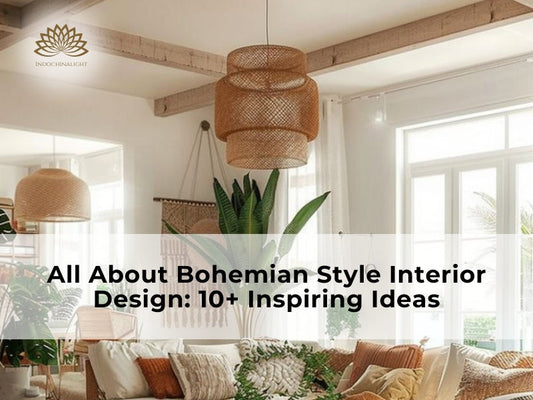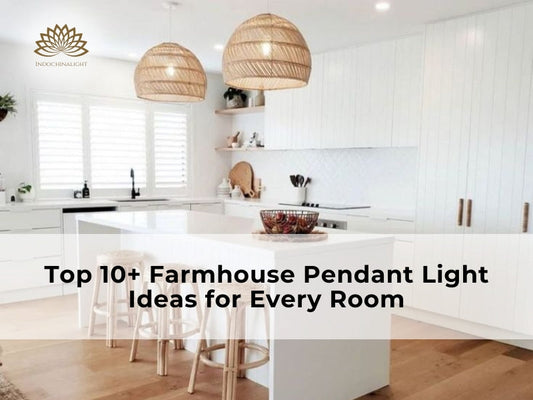Rustic interior design embodies nature's raw essence through aged woods, textured stones, and organic materials. This design approach transforms spaces into serene sanctuaries that celebrate imperfection and authenticity. Rustic design creates grounded and timeless environments by incorporating natural elements and handcrafted pieces.
This guide from IndochinaLight explores the fundamentals of rustic interior design, from its defining characteristics to practical implementation strategies. You'll discover how to blend natural materials, select appropriate color palettes, and incorporate authentic design elements. Whether you're renovating a country home or adding rustic touches to an urban dwelling, these insights will help you create functional and aesthetically cohesive spaces.
What Is Rustic Interior Design?
Rustic interior design emphasizes raw beauty through unrefined materials and organic textures. This design philosophy emerged in early 19th century America when pioneers crafted homes using local materials out of necessity. The style celebrates imperfections - knots in wood, patina on metal, and natural variations in stone become distinctive features rather than flaws.
The approach focuses on authenticity, favoring handcrafted elements over mass-produced items. Natural materials like wood, stone, and metal form the foundation, while handwoven textiles and artisanal pottery add layers of texture. Modern interpretations include farmhouse, coastal, and contemporary rustic variations, each maintaining core elements while adapting to current lifestyles.

Rustic interior design emphasizes raw beauty through unrefined materials and organic textures
Key Characteristics of Rustic Design
Rustic design encompasses 7 fundamental characteristics:
-
Neutral Colors: A monochromatic palette of earthy tones like beige, white, brown, and gray fosters warmth and serenity. Add occasional pops of green or blue for depth.
-
Natural Materials: Elements such as wood, rattan, bamboo, stone, and burlap exude authenticity. Reclaimed wood, a staple, adds history and texture.
-
Textures: Materials like jute, canvas, and burlap create a tactile, layered aesthetic that enriches the environment.
-
Fabrics: Unembellished linens and organic cotton in soft tones reinforce the understated elegance of rustic spaces.
-
Handcrafted Décor: Artisanal items—woven baskets, clay pottery, and hand-carved furniture—add character and craftsmanship.
-
Rustic Structural Features: Exposed beams, stone walls, or wood-paneled floors emphasize architectural charm, harmonized by strategic lighting.
-
Comfy, Weathered Furniture: Vintage or repurposed furniture offers comfort and a sense of story.

Rustic design encompasses 7 fundamental characteristics
Rustic House Interior Do's and Don'ts
A rustic interior design encapsulates nature's charm and warmth. Following the right guidelines ensures the space feels authentic and welcoming. Use this table to simplify your approach:
|
Do
|
Don’t
|
|
Add natural elements
|
Use contemporary materials like plastics
|
|
Opt for a neutral natural color scheme
|
Incorporate contrasting colors
|
|
Play with oversized furniture and fabrics
|
Choose glossy finishes
|
The successful implementation of rustic design relies on embracing natural elements while avoiding artificial materials and finishes. Natural materials age gracefully, developing character over time. Focus on creating a lived-in atmosphere through thoughtful material selection and authentic decorative elements. Remember that rustic interiors should feel evolved rather than staged, celebrating the inherent beauty of natural materials and craftsmanship.

The successful implementation of rustic design relies on embracing natural elements
Types of Rustic Design
Rustic style comes in six unique types, each blending natural charm with distinct aesthetics:
-
Modern rustic style: Combines traditional rustic materials like reclaimed wood with modern elements such as glass, wrought iron, and colorful decor for a contemporary twist.
-
Farmhouse rustic style: Features rustic materials with a streamlined, industrial-inspired farmhouse look, merging cozy charm with functionality.
-
Cottage rustic style: Highlights distressed and reclaimed decor in airy, bright rooms with light-colored walls and soft textiles.
-
Western rustic style: Reflects American rustic traditions with touches of Western and Southwestern design, including rodeo motifs and animal-hide rugs.
-
Scandi rustic style: Blends Scandinavian minimalism and a lighter palette with rustic elements like handcrafted furniture and distressed wood.
-
Industrial rustic style: Merges utilitarian industrial aesthetics with rustic warmth, creating sleek yet inviting spaces inspired by repurposed industrial settings.

Rustic style comes in six unique types
How to Decorate With Rustic Style
Transform your space with these 13 practical rustic decorating ideas. These guidelines help create authentic rustic environments while maintaining functionality and comfort. Each approach builds upon core rustic principles to develop cohesive, inviting spaces.
Use Organic and Natural Materials
Integrate raw materials throughout your space. Use stone for fireplaces and accent walls. Install wood flooring and beams. Add cotton and wool textiles in earth tones. Include living elements through plants and herbs. Feature rattan and bamboo lighting fixtures to enhance natural textures and create a warm ambiance.

Integrate raw materials throughout your space
Incorporate Reclaimed and Weathered Wood
Utilize reclaimed wood elements as focal points. Install weathered planks for flooring or wall treatments. Choose furniture pieces featuring distressed wood finishes. Add iron hardware and metal accents to complement wooden elements. Select pieces that tell stories through their aged appearance and previous uses.

Utilize reclaimed wood elements as focal points
Highlight Rustic Exposed Beams
Install exposed beams to create architectural interest. Select wood with visible grain patterns and natural imperfections. Position lighting fixtures to emphasize beam textures. Paint surrounding surfaces in lighter shades to create contrast with darker wood tones. Use beams to define spaces and add vertical dimension.

Install exposed beams to create architectural interest
Choose Sturdy and Heavy Materials
Select substantial furniture pieces that ground spaces. Install stone features for permanence and texture. Use wrought iron fixtures for durability and style. Add thick textiles for comfort and visual weight. Incorporate metal-framed lighting to balance delicate and robust elements.

Select substantial furniture pieces that ground spaces
Stick to Neutral, Earthy Color Palettes
Natural color variations create depth. Apply soft browns, sandy beiges, and slate grays to walls and large surfaces. Introduce forest greens and ocean blues through textiles and accessories. Layer neutral tones with organic lighting fixtures like bamboo pendants to enhance visual warmth. Balance lighter and darker shades to maintain visual interest.

Create depth through natural color variations.
Add Warm And Cozy Color Tones
Layer spaces with rich earth tones. Include terracotta accents, amber details, and deep mustard elements to create warmth. Install rattan pendant lights to cast soft, welcoming illumination. Add textured throws and cushions in warm hues. Balance bold colors with neutral foundations to maintain harmony.

Layer spaces with rich earth tones
Mix Rugged and Smooth Textures
Create depth through textural contrasts. Combine rough jute rugs with smooth wooden surfaces. Layer stone elements with soft linens. Position rattan lighting to highlight surface variations. Balance coarse and refined materials throughout spaces. Use texture to add visual interest while maintaining rustic authenticity.

Create depth through textural contrasts.
Select Simple and Functional Furniture
Choose pieces that serve clear purposes. Select furniture made from solid wood and iron. Focus on clean lines and practical designs like storage benches. Add understated bamboo pendant lights to complement furniture pieces. Maintain visual weight through substantial materials while avoiding ornate details.

Choose pieces that serve clear purposes
Prioritize Handmade and Artisan Decor
Incorporate pieces with visible craftsmanship. Display handwoven baskets, pottery, and custom furniture. Install artisan-crafted rattan pendant lights. Include personally created elements. Celebrate natural variations and handmade qualities in each piece. Let imperfections add character to spaces.

Choose pieces that serve clear purposes
Install Rustic Barnyard-Style Doors
Add sliding barn doors for practical division. Use reclaimed wood with visible grain patterns. Install black iron hardware for authentic details. Position doors to maintain open flow between spaces. Complement with rattan pendant lighting to unify design elements. Create focal points that serve both form and function.

Add sliding barn doors for practical division
Light Up with Rattan Pendant Fixtures
Transform spaces through strategic lighting placement. Install rattan pendant lights above dining tables and kitchen islands. Select varied sizes and weave patterns to create visual interest. Position fixtures at different heights for dynamic appeal. Use warm bulbs to enhance natural materials and create intimate atmospheres.

Transform spaces through strategic lighting placement
Create a Rustic Kitchen Ambiance
Build character through natural elements. Install reclaimed wood countertops and open shelving for practical storage. Add metal hardware with aged finishes. Choose stone backsplashes in earth tones. Position bamboo pendant lights above work areas to unite design elements and provide task lighting.

Build character through natural elements.
Design a Treehouse-Inspired Porch Retreat
Extend rustic design to outdoor spaces. Install rough-cut wooden planks for authentic flooring. Choose weather-resistant furniture with natural patinas. Add living elements through strategic plant placement. Mount outdoor-rated rattan pendants to create an evening ambiance and define gathering areas.

Extend rustic design to outdoor spaces
Rustic vs. Farmhouse Interior Design Style
Understand key style distinctions while recognizing shared elements. Both styles emphasize comfort and functionality through natural materials. Farmhouse design features refined finishes and structured arrangements. The rustic design maintains raw material characteristics and organic forms. Farmhouse incorporates polished elements while rustic celebrates natural imperfections.

Both styles emphasize comfort and functionality through natural materials
This guide provides comprehensive strategies for implementing authentic rustic design. Through careful material selection, thoughtful lighting placement, and attention to natural elements, you can create spaces that honor rustic traditions while meeting modern needs.
The guide covers foundational principles, design variations, and practical implementation techniques. From material selection to lighting choices, each section builds an understanding of rustic design elements and their application.
IndochinaLight offers handcrafted rattan and bamboo pendant lights that complement rustic design principles. Our artisanal fixtures provide warm illumination while adding natural texture and visual interest to your spaces.
IndochinaLight - IndochinaHomeDecor LLC
-
Email: service@indochinalight.com
-
Address: 30 N Gould St Ste N, Sheridan, WY 82801
-
Phone: +1 (307) 249 0594





